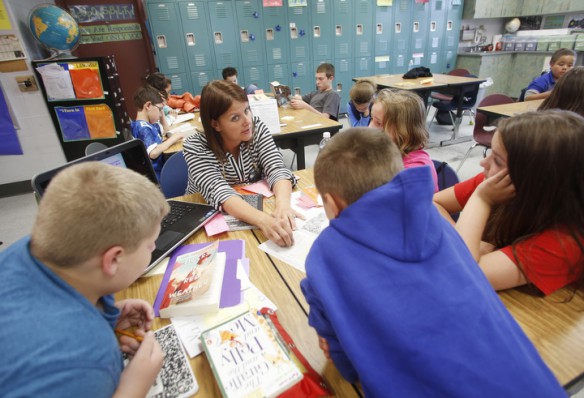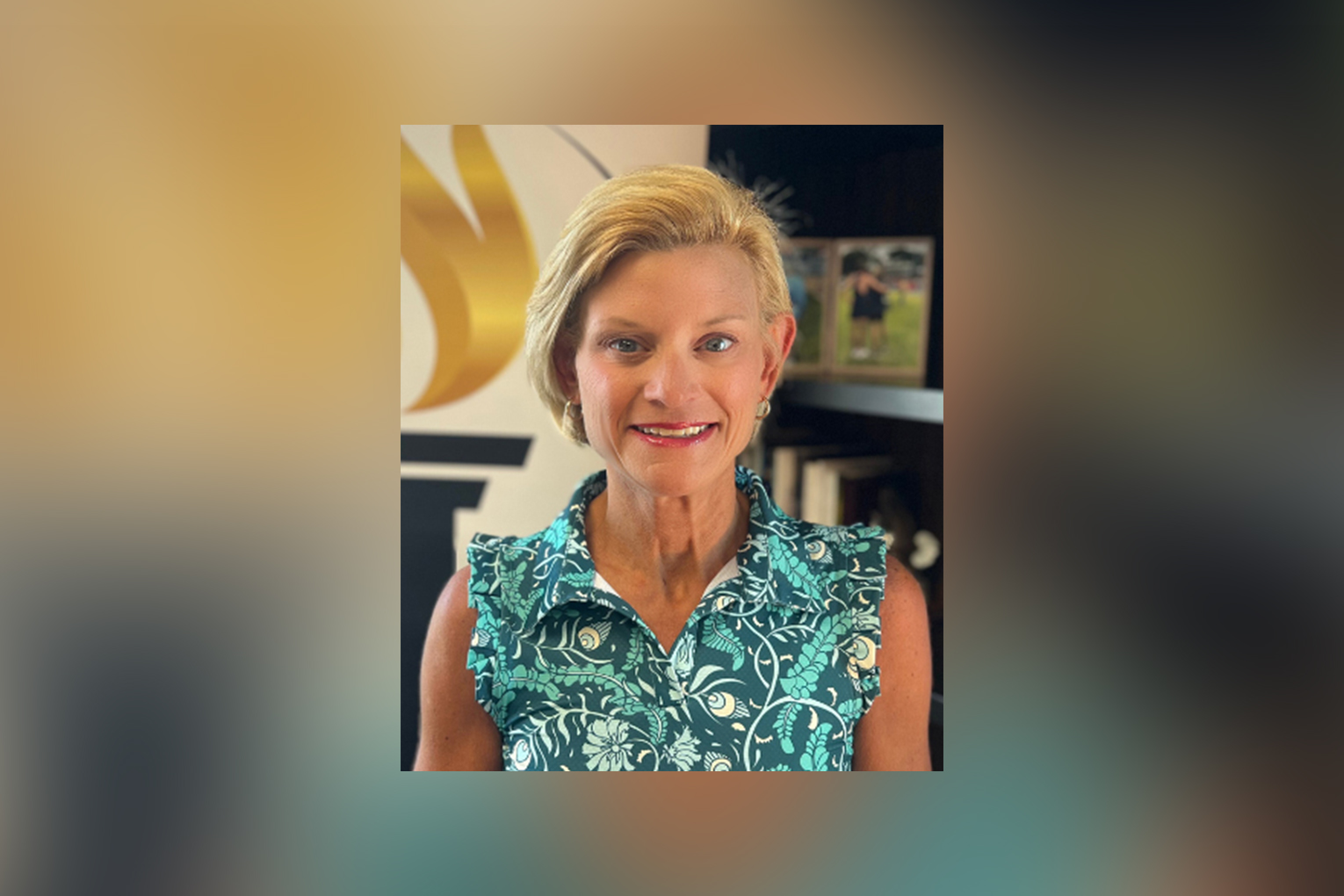
Gigi Pattison focuses on synthesizing from reading with a small group in her 5th-grade class at Clear Creek Elementary School (Shelby County). As part of using differentiated instruction in her class, other groups focused on determining the most important information and monitoring for understanding while reading.
Photo by Amy Wallot, May 16, 2014
By Susan Riddell
Kentucky teachers know the impact differentiated instruction has on getting all students college- and career-ready, and that’s why they are asking for more resources and professional development (PD) for it.
“At the Kentucky Department of Education (KDE) we want to ensure that we are meeting the professional development needs of teachers throughout the state,” Bart Liguori, KDE research analyst, said. “Educators’ ability to differentiate instruction using Kentucky Core Academic Standards (KCAS) will greatly impact our goals of graduating more students college- and career-ready.”
Based on recent Teaching, Empowering, Leading and Learning (TELL) survey results, nearly 40 percent of state teachers said they have not had at least 10 hours of differentiated instruction PD in the past two years, and 31 percent of Kentucky teachers said they don’t have enough time to get optimum results in regard to instructional practices and supports that cover aspects of teaching it.
Whether it’s modifying the content, process or the learning environment, the key to making differentiated instruction work is constant reflection. That may be based on an individual student or looking at the teacher practice when assessment results aren’t proficient, teachers said.
“It doesn’t happen overnight,” said Nicole Shelby, who teaches 4th grade at Benton Elementary School (Marshall County). “For differentiated instruction to be effective, teachers have to design lessons and instruction carefully.
“For me, the key to knowing whether differentiation is working is by constantly assessing student performance and understanding. Assessing results helps me have a better understanding of my students’ abilities and needs. Assessments are used for future planning. If I see that students are not mastery at a skill, I reflect on my instruction and look for ways to improve.”
Gigi Pattison, a 2nd-grade teacher at Clear Creek Elementary School (Shelby County), uses a conferring binder that helps her keep anecdotal notes on every student in her class. Each child has a grid for her to write down daily notes inside the binder.
“I refer back to these notes often so that I can get to know the students as individuals,” Pattison said. “Each conversation that I have with students is tailored to their needs and what they need to work on. This binder gives me what I need to also give feedback to parents and special education teachers.
“An additional way that I keep track of student success is exit slips on the particular skill that we’re working on,” Pattison added. “If I see that student scores are increasing, then I also know it is working. Sometimes, student scores decrease, are scattered or stay stagnant. When this occurs, I know that I need to do some investigating in order to pinpoint what is hindering student growth.”
Pattison said trial and error helps her with differentiated instruction, too.
“If I notice something is not working, I branch out to people, go online or read books to find how I can make it successful,” she said. “I have often had that moment of ‘This is not working. Why?’ When this occurs, I either try something completely new, or I (slightly) change up what I’ve been doing.”
Student engagement is a priority with differentiated instruction for Pam Quinn, who teaches 2nd grade at Green County Primary School.
“Second graders can be exuberant, and their enthusiasm is hard to contain. It is easy to spot when kids are just going through the motions,” Quinn said.
Quinn recently used a peer-to-peer activity that showed positive student engagement and proved to be a successful differentiated instruction lesson, she said based on how she changed the process.
Students had a writing prompt for explaining what they did over spring break. Instead of having them read their own works aloud, students swapped journals. They read entries and summarized what classmates had written. Students also assessed their writing based on sentence structure, punctuation and spelling.
“Engagement was through the roof,” Quinn said. “Peer-to-peer critiques have evolved from the beginning of the school year. I spent a lot of time modeling and providing student support. They can now effectively critique each other’s writing giving both positive feedback and areas for improvement.”
While differentiation comes in different forms and can be used for multiple subjects, it also is critical that students see their growth regularly no matter what the situation is.
Brian Recktenwald also teaches at Clear Creek Elementary. He teaches 5th grade and is a collaboration teacher focusing on reading, writing, mathematics, science and word work.
“In math that means showing each student his or her growth from a pretest to his or her post-test,” Recktenwald said. “In math students who need assistance or intervention would have the chance to use concrete manipulatives to assist with math concepts. It would be creating guided math and reading lessons that have math and reading stations focused on students centered skills.”
Recktenwald said reading differentiation hinges on allowing students a choice in their reading while focusing on appropriate learning strategies and concepts.
“In writing, it would be showing students growth over time and working on student specific areas where they need help,” he said. “Some students might need additional help with idea development in their writing. Other students might need more instruction with the structure of their writing. Good differentiated instruction includes working with all students at their own instructional level across content areas.”
Impact on KDE initiatives
Differentiation is something that touches several major KDE initiatives, teachers said.
Recktenwald said making sure students understand their progress can come into play when teachers are held accountable for measuring student growth within the Professional Growth and Effectiveness System (PGES).
He recently had a student take a summative unit fraction test. The student was disappointed she only scored a 75 percent when her goal was 80 percent. While she didn’t reach her goal, she made significant gains.
“When I showed her pretest score of 20 percent, she could see her growth, and that made her work pay off,” Recktenwald said. “From what I hear, PGES is looking to make differentiation a priority. The fact that student growth will be measured is an important piece to measuring student success and teacher quality.
Pattison noted that Program Reviews allow for students to benefit from project-based learning and ones like the Arts and Humanities Program Review easily fall in line with different learning styles.
Differentiated instruction is especially important for Kentucky Core Academic Standards (KCAS), according to Quinn.
“KCAS is the foundation for my instruction,” Quinn said. “My teaching core standards in different ways and at higher levels increases the likelihood my students will be successful in learning and transferring knowledge to other areas.”
All of these statewide initiatives – and more – benefit from top-notch differentiated instruction Shelby added.
“Through research we know that best practices in the classroom include use of assessment to inform instruction; Response to Intervention; higher ordering thinking and discussion; flexible grouping; and student ownership for learning,” Shelby said.
“All of these components are avenues to differentiation in the classroom,” Shelby added. “I do not think any of the state initiatives depends more on high quality differentiation over another because they are all so intertwined. To me, if high quality differentiation is used, everything else will fall into place.”
MORE INFO …
TELL survey
Gigi Pattison, marjorie.pattison@shelby.kyschools.us, (502) 633-3452
Pam Quinn, pam.quinn@green.kyschools.us, (270) 932-6619
Brian Recktenwald, brian.recktenwald@shelby.kyschools.us, (502) 633-3452
Nicole Shelby, nicole.shelby@marshall.kyschools.us, (270) 527-3373







Leave A Comment